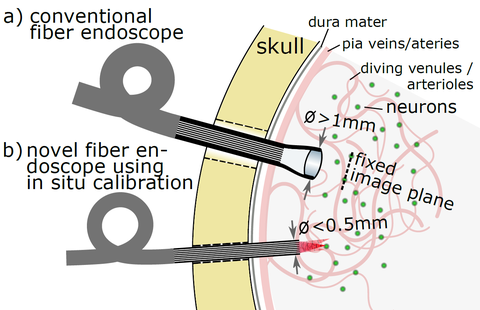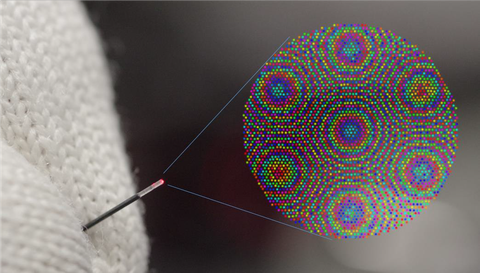Lensless Holographic Endoscopy
State of the art for imaging hard to reach areas for instance in medical diagnostics are fiber bundle based endoscopes. Their working principle is based on the transmission of intensity patterns. In order to image scenes from inside a volume it incorporates a lens system at the distal fiber facet. The following limitations arise:
- Pixilation: Fiber bundles offer up to 100.000 pixels which is limiting the amount of resolvable information
- 2D: Pure intensity imaging via fiber bundles offer no 3D information
- Size: The distal optics required for imaging limits the minimal footprint of endoscope to above one mm and their applicability
Holographic Endoscopy is expanding on the above principle to evaluate the phase information additional to the intensity. First the requires off, this requires a calibration of the optical transfer function of the fiber bundle. We developed and patented a technique for in-vivo calibration [1,2]. The approach offers key advantages such as:
- Minimal invasiveness: Diameters down to below 300 µm since distal optics are not required
- 3D with micron resolution: Volumetric microscopic imaging by fast raster scanning techniques or single shot holography in bio science but also for production metrology
- Additional flexibility: Phase control of sending light enables using light as a tool for instance for laser dissection, optogenetic cell stimulation, 3D printing or mechanical cell manipulation
Cooperation: We are always looking for partners such as clinicians, bio scientists or industrial partners for instance in the fields 3D in-vivo endomicroscopy, Optogenetics, operation monitoring, flow metrology, cell mechanics, bioprinting, production metrology or any other where you want to control or detect light in confined spaces.
[1] J. Czarske and R. Kuschmierz, Method and fibre-optical system for illuminating and detecting an bject by means of light, US10520594B2, 2019.
[2] R. Kuschmierz et al., Self-calibration of lensless holographic endoscope using programmable guide stars, Opt. Lett. 43 (12) (2018


